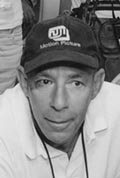


|
Alumni Profile
Moviemaking Made Magical
Phil Parmet, BS’65 (M), knows the power of his craft. The veteran filmmaker says, “People respond to movies as if in a dream. Movies work on the same level as poetry, music and dreams.” This is true, if they’re made by people like Parmet.
A cinematographer and still photographer, Parmet has more than 30 feature-length movies to his credit, and his photos have been shown internationally. He explains that a cinematographer “designs the lighting and collaborates with the director on the film’s visual look. You use the cinematography as a way of counter pointing and determining a point of view.” Parmet’s fascination with cinema and film began in his teenage years when “my dad handed me a camera, and I received a darkroom kit at the age of 12.” His entrepreneurial spirit took hold while in high school when he rented an airplane and took aerial photographs of houses. “I peddled the pictures door-to-door to the homeowners.” Interestingly, it was while a senior at Fairleigh Dickinson University that friends from his hometown of Princeton, N.J., were making movies and asked for his help. That year, Parmet also developed an experiment to test a theorem in an experimental psychology class. “I did a ‘flicker frequency’ test that sought to determine at what point an image flashed on screen enters a person’s perception or affects that person on a subliminal or subconscious level.” He credits Fairleigh Dickinson with giving him “a solid, liberal education that has been valuable to me over the years.” |
||
|
While attending graduate school at the Annenburg School of Communication, University of Pennsylvania, Parmet was exposed to Italian neo-realist cinema “and it just opened the world for me. I realized films could inform and excite you, not just entertain you. I started to seriously think about filmmaking after that.” His love of the subject brought him back to FDU in the late 1960s to teach filmmaking and film history. “No one taught film history in those days, and I just put together something unique.” After two years of teaching, Parmet started working in New York City for the networks. It was during this time that he made a film on The Tombs, New York City’s infamous jail. “I sold it to ‘60 Minutes’ in 1974, and they aired it; I don’t know if I had anything to do with it, but The Tombs closed down in 1975.” Parmet then joined a British documentary company and traveled worldwide. But the documentary world was changing in the 1980s. He explains, “The documentaries became more tabloid and less journalistic, and I was not interested in that kind of work.” So he moved to California in 1990 and plunged into feature films. His movie “In the Soup,” with Steve Buscemi, won the Grand Jury Prize at the Sundance Film Festival in 1992. “That gave me a bit of a name in the business.” Parmet also is an accomplished photographer with gallery shows in New York City, Los Angeles, Paris and Berlin. Many of his photos can be viewed on his Web site, www.eyeandeye.com, along with clips from some of his more recent movies. One of those, “American Gun,” is the last movie James Coburn appeared in before his death in 2002. “I loved him; he was such a great person and truly a special actor.”
Despite Parmet’s experiences with such luminaries, his feet are firmly planted, and he is devoted to his wife, Lisa, and his daughter, Laurel. He describes his daughter as “an amazing child. She is an incredible young woman, and it is an extraordinary experience to be her father.” Although a veteran cinematographer, Parmet has just completed a film script for production this year. “It’s a gothic horror film that spans two generations of a family during and after the Civil War,” he says. “It’s a grown-up ghost story; the kind you might have heard around a campfire.” He finds the writing process “interesting. It’s amazing how a story grows and leads you up different avenues.” And for Phil Parmet, the challenges of filmmaking — whether filming a performance or writing a story — remain a source of excitement and magic. “What I capture on film is the work of actors, directors, set people, costume people, designers, computer artists and writers as well as other creative people. It’s an indescribable feeling. When it really works, it’s like an alchemy that is supernatural.” — M.D. |
||
|
FDU Magazine Directory | Table of Contents | FDU Home Page | Alumni Home Page | Comments |
|||